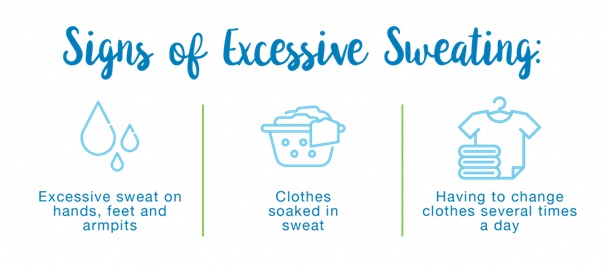Excessive Sweating
Excessive Sweating


- Nervous system conditions e.g. Parkinson’s disease
- Metabolic conditions e.g. overactive thyroid, diabetes.
- Gout
- Menopause
- Alcoholism
- Infections e.g. tuberculosis.
- Certain cancers may cause “night sweats” – excessive sweating during sleep.
- Stress or anxiety
Some medications may cause liberal sweating e.g. certain painkillers, zinc supplements, antidepressants, insulin.3,4
- Visible sweating (beading or dripping sweat, wet clothing).
- Sweaty hands causing difficulties with e.g. holding pens, turning door knobs or using a computer.
- Skin that stays wet for long periods, becoming soft and peeling.
- Skin irritation and infection in sweat-prone areas.
- Body odour.
- Sweat-stained clothing.
Symptoms suggest whether excessive sweating is primary or secondary. Primary focal hyperhidrosis typically:
- Affects one area of the body, or just a few.
- Occurs on both sides of the body e.g. both hands.
- Starts after waking up.
- Occurs at least once a week.
- Begins before age 25.
Secondary generalised hyperhidrosis usually starts in adulthood, and may affect the whole body. It may occur during sleep.1,4

Tips to manage excessive sweat:
- Shower more frequently.
- Wear breathable, loose-fitting natural fabrics.
- Wear absorbent socks; change them often.
- Avoid enclosed boots and sports shoes; swap shoes out daily.
- Try armpit sweat shields to protect clothing.
- Try foot powder for sweaty feet.
- Identify and avoid triggers that worsen your sweating e.g. alcohol, spicy food.5
OTHER OPTIONS:
If you find these initial measures aren’t sufficient, you and your doctor can look into further options: Oral medications called anticholinergics cause a drying reaction and can make aluminum-based antiperspirants work better. These may be useful for surplus sweating in multiple areas of the body. Your doctor may recommend an antidepressant or other anti-anxiety medication if stress or anxiety seem to cause excessive sweating.2,4 Iontophoresis uses a weak electrical current to block the sweat glands. Botox injections temporarily block the nerves that make you sweat, reducing sweating for three to six months. Microwave thermolysis uses microwave energy to destroy the underarm sweat glands. Only 2% of sweat glands occur in the armpit, so the body’s cooling ability isn’t affected. Surgery can remove sweat glands or disconnect the nerves that control the sweat reaction, in severe cases that don’t respond to other therapies.1,2,3 Psychotherapy can be helpful in reducing negative emotional reactions that cause stress and anxiety, which in turn may be causes of excessive sweating.2
- It persists for at least six months.
- It occurs at night.
- You have a family history of excessive sweating.
- You’re taking medication for another condition.5
Your doctor will likely do a physical exam and take your medical history, and may also do a non-invasive test to measure the level of sweating, e.g. using a device called a vapometer to measure the amount of sweat from hands, underarms, feet and scalp.2,4 You may need other tests if an underlying condition is suspected.5


Medical References







